In his 1868 prose poem Les Chants de Maldoror, the self-styled Comte de Lautrémont described a young man as being as beautiful as the “chance encounter of a sewing machine and an umbrella on a dissecting table” — a startling image that would inspire the surrealist movement in art half a century later.
Thanks to advances in artificial intelligence (AI), we no longer have to rely on an artist’s vision and talent to imagine what such an encounter would look like. AI image-generating programs combine machine learning algorithms with the internet’s massive trove of pictures and their associated metadata to create a practically infinite catalog of original images, limited only by the combinations of words used to call them into being.
While computer-generated imagery isn’t new, the technology has become more familiar — and scrutinized — over the past year as it’s become exponentially more powerful. A Colorado artist made headlines a few months ago when he used one of these programs, Midjourney, to win a digital fine art competition. The open-source Stable Diffusion has already been the subject of much handwringing because of its potential to spread even more visual disinformation than older technologies like Photoshop have already made possible.
And then there’s DALL-E, which has emerged as the leading image generator in the field. Its name — a portmanteau of Salvador Dalí and Pixar’s Wall-E — gives clues to its purpose: a self-instructing automated entity that generates endless and frequently surreal combinations of images, art styles, and abstract concepts. (The association is presumably meant to invoke the wildly creative younger Dalí and not the huckster he became — though given that DALL-E’s San Francisco-based parent company OpenAI stands to profit handsomely by licensing the program, maybe late-stage Dalí is also one of the program’s guiding spirits.)
Access to DALL-E was limited to invited users from its release in January 2021 until last month when OpenAI released DALL-E 2 and opened it up to everyone. (You can play around with it yourself at openai.com/dall-e-2.) The process couldn’t be simpler: describe something in a text phrase, or “prompt,” and DALL-E creates a picture of it. An impressionist painting of Mickey Mouse surfing on top of the Pilgrim Monument? It’s just a few clicks away. (To help prevent its use for nefarious purposes, DALL-E won’t allow prompts that include identifiable people; anything illegal, violent, or sexually explicit won’t make it through its filters either.)
Twenty years after its invention, photography was described by Baudelaire as “art’s most mortal enemy” and “the refuge of every painter too ill-endowed or too lazy to complete his studies.” Some reactions to DALL-E and its ilk in the contemporary art world have been similar. Is it a new kind of art form or the latest art fad? (Remember NFTs?) Or is it an existential threat to human creativity itself?
I first asked my colleagues, writer and painter Abraham Storer and photographer Agata Storer, what they thought. We decided to invite a few other local artists to experiment with the technology to see whether it’s something that presages the eventual obsolescence of fine art or simply another tool for inspiration and experimentation like digital tablets, acrylic paint, and photography — all of which were met with skepticism when they were introduced. After all, even Baudelaire eventually admitted that photography could at least be useful as “the servant of the sciences and the arts.”
Their AI-generated images and the prompts that created them follow.
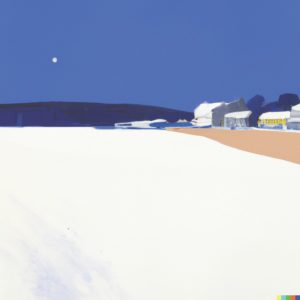
A minimalist painting of Wellfleet in the snow.
“I wanted to create an image that would look like something I would want to paint, or something I have painted in the past. The system seems to have a sophisticated knowledge of composition and an understanding of winter colors. One of the images I generated shows an uncanny resemblance to the oceanside beaches; others seem more derived from the area around the pier. They got a few things wrong, like the scale of local architecture and oversized hills. I found the images emotionally moving, which surprised me. The machine relies upon a deep history of creative human endeavor.” —Abraham Storer
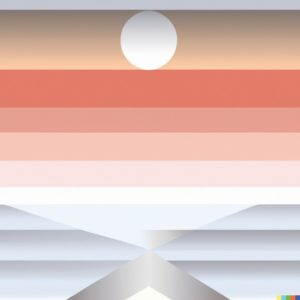
A geometric painting of a sunrise on a winter day that is nearly completely in shades of white, Sol Lewitt-style.
“I used this prompt because I want to create new paintings and am looking for inspiration. I found that unless I identified a specific well-known painter (in this case Sol Lewitt) nearly all the images generated were impressionist in style, and that’s not what I was looking for. This is not the first time I’ve used AI image generators to brainstorm inspirations. It’s a good way to get the wheels turning. I don’t aim to reproduce the images generated but rather to source ideas. I find this particular image interesting since it has elements that echo my style, with some variations in color and composition that I possibly wouldn’t have thought of by myself.” —Gaston Lacombe
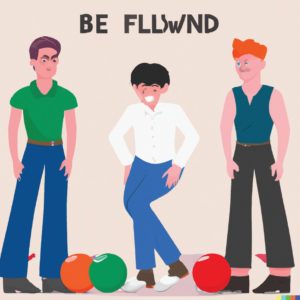
A gay man bowling with straight men.
“My first prompts were aimed at generating images of the male figure — and particularly gay male figures — to see how DALL-E would depict these differences. After playing around I became significantly less impressed with the artistic merits of the generated images and more interested in their social implications. I found this particular image funny — and a bit troubling. The gay figure in the center has a stereotypical posture and his straight bowling mates look slightly amused (or embarrassed, confused, and/or horrified) by having him in their presence.” —Michael Lyons
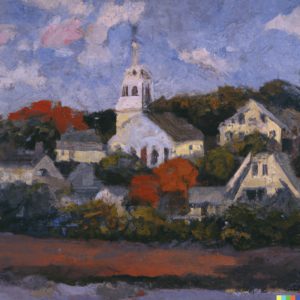
A plein air style painting of a New England coastal town in October at dusk.
“When I tried this prompt, it spit out some paintings that felt vaguely familiar — but none that looked like mine, which was a relief. Materials are really important to me, and AI can’t replicate that. The presence of the human hand — the crookedness and imperfection of things — will always be important. I can see it being a useful tool, even if it’s not for me. But it’s only going to get better the more we use it.” —Karen Cappotto
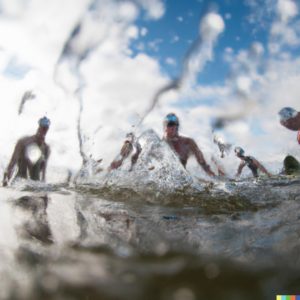
Looking up through the water at triathlon swimmers starting a race.
“I’m always looking for images from beyond my imagination as painting references. The story I want to tell is not something I could easily stage, even if I had a model. I often look for an underwater viewpoint. I found that the AI doesn’t know how to carry a canoe — and probably other experiences are still foreign to the robot, like visualizing the sea floor. It’s fun to think I could lead my AI into those experiences.” —Mark Adams
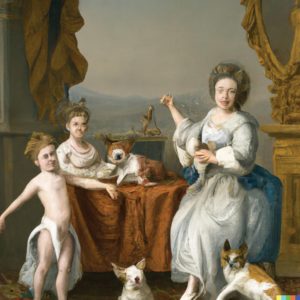
A mannerist painting of manners.
“I have always been interested in language and meaning and the gap between what we intend to say and what is heard and understood — possibly where almost all of life occurs. Trying this is a bit like that gap and a bit like learning a new language. I found I had resistance to learning on an algorithm’s terms, but I also wanted to win a game by getting interesting images. It seems to like associations between literal ideas and not to be at all poetic, and most infuriatingly views abstraction as data. Mainly, it made me want to paint.” —Mike Carroll

A photograph of a transparent retro angel ghost standing over a bed in an old movie style, 1920.
“I decided to try creating photographs that wouldn’t have been possible in a particular time period without a lot of darkroom work: something ephemeral and transcendent. After playing a while with the idea, I settled on images of angels. For me, DALL-E is a tool that is scary in how well it produces good quality artworks — as well as something that is very exciting to work with. One’s imagination is the only limit.” —Agata Storer
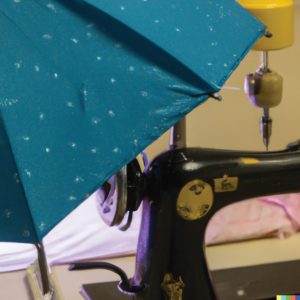
A chance encounter of a sewing machine and an umbrella on a dissecting table.
Just because. —John D’Addario
